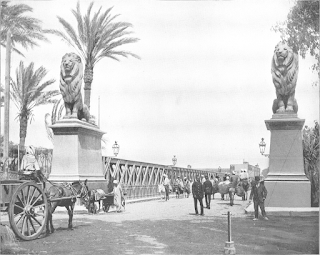Approach to the Nile Bridge
Approach to the Nile Bridge
In the olden time, as in 1863, when the writer first visited Egypt, the passage of the Nile was made by a small ferry boat in company with horses, donkeys, peddlers, farmers, beggars, tourists—a motley crowd. Now, one may cross the bridge Kasar en-Nil. It is a bridge of iron one thousand two hundred and sixty feet long and has strong stone buttresses. It is a comfortable thing in these days to take a carriage instead of a donkey, in Cairo, to cross the bridge instead of a ferry and to enjoy an unbroken ride over a smooth, finely macadamized road under the shade of acacia trees to the foot of the ridge on which the pyramids stand. We went in 1863 on a donkey over a narrow tortuous path, and what required several hours at that time may now be accomplished in about an hour and a half. It is sometimes the case that the bridge is swung open for two hours at the time for the passage of boats, and it behooves the tourist to watch the right time for leaving his hotel for the pyramid excursion. There is in the picture above, a touch of the ancient orient, palm trees, donkeys with their drivers, or carts and riders, the long robes and the white headgear of the natives. Two high towers stand at the opening of the bridge, on each of which is a lion couchant. In these days the natives, we have no doubt, think that these images represent the British lion which keeps careful watch over everything pertaining to modern Egypt. Once across the bridge, we turn into the broad and beautiful Pyramid road.




Comments